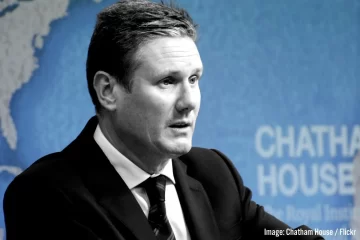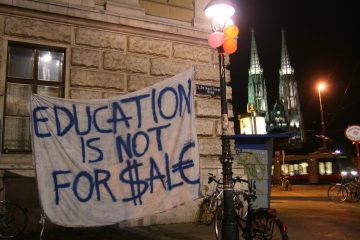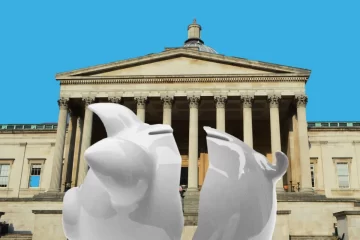In May 2013 it was announced that the University of London Union (ULU) will close in August 2014. Given its nature as a focal point for student activism and protest in London and nationally, the closure of ULU is likely, in this respect, to be – at least partially – politically motivated.
Students have repeatedly mobilised over the past period against the threat of ULU’s closure. The latest protests have provoked a violent response by the ULU management through the use of private and public security forces.
Occupation
On Wednesday 4th December, a group of students decided to occupy the Senate House (the emblematic building of the University of London) to protest against the ULU closure and about a variety of other issues relating to the wider student and labour movement, including: the rejection of university fees and the – recently announced – privatisation of student debt; the conditions of university staff, in particular that of outsourced security and cleaning workers; and the attacks on lecturers and other university staff, who recently held another one-day strike across the UK.
The raising of these wider questions is to be applauded, as it is around such issues that the student and labour movement can be united and built. It is on the basis of these – ultimately political – questions that the majority of student and workers can be engaged in a common struggle against the coalition government and the root problem: the capitalist system.
At the 4th December occupation, students were, for the first time in many years, immediately given an authoritative ultimatum to compel them to leave the building. Students refused, and local security, with the help of the London Metropolitan Police, evacuated the building with the use of brutal force. Such excessive use of force took students by surprise. Different reports coincide on the fact that punches and kicks – from the police to students involved – were indiscriminate and that arrests happened randomly. Five students were arrested and, eventually, both police and students went home. You can see a 10 min video of the events here.
According to ULU management and the police, students had allegedly blocked emergency exits and represented a threat to the security of UoL’s personnel still in the building. Reports from students, however, state that policemen provoked them, and that the building’s security staff stole electronic equipment from them, accusing the students of vandalism.
Police brutality
The police brutality witnessed during these episodes must be condemned. We must also emphasise that this police presence and brutality is result of the decisions made by the management of UoL.
On the afternoon of Thursday 5th December, 200 students marched on campus, demanding that the police be forbidden from campus, and accusing both private and public security bodies of having applied excessive force in the eviction of Senate House on the Wednesday. The demonstration was eventually led off the campus and, close to Euston Square, students were harassed and arrested, with 36 spending the night in jail.
After Thursday’s demonstration, an assembly took place at ULU’s main building. Presided over by Michael Chessum, President of ULU, the assembly discussed the nature, objectives and strategies of the anti-police demonstrations and called for a nationwide day of action.
Apart from the very important coordination of support for those arrested, the discussion at this assembly went on to the immediate action that students should take. Importantly, it was agreed within the assembly that it would be useless to limit the demands of any campaign to simply having police-free campuses. The call for a broad student movement, linking the question of police brutality and repression to the wider role of the police as a force of the state, used to protect the interests of the rich, was supported by the majority of those present at the assembly.
In this way, the link was made between police brutality and the austerity policies of the Tory-led Coalition, who use the police to repress any resistance from students and workers to their programme of the bosses and bankers.
Recognising such links is important, as it is vital for students to recognise that their struggle is not isolated from the other demands made by workers and staff in universities and in the wider labour movement.
Which way forward?
When the moment came for the assembly to make a decision on the actions to be carried out, however, no agreement could be reached. Almost equally split, the assembly debated for almost one hour whether the students’ reaction should limit itself to occupying the campus, or if it should organise a massive demonstration.
Arguments in favour of occupation were mainly presented by anarchistic students, who showed open mistrust towards “any kind of political organisation, and that includes trade unions and political groups”. These students argued that massive demonstrations have already failed in the past and that there is no way that the student movement can share a political programme with existing organisations. They argued that blocking the campus would at least make people think about the whole situation.
As opposed to this proposition, the other half of the group called for a massive mobilisation with full coordination with other organisations – especially the trade unions present in universities: UCU, UNITE and UNISON. Three representatives of UCU accepted the proposal, but showed an understandable attitude of hesitation when they declared, in private, that they still didn’t fully support this option because “here we’re dealing with students that somehow think that we’re not radical enough”.
Given the above mentioned views of the anarchists in favour of occupation, as against working with the organisations of the staff on campus, this attitude from the UCU members is understandable and is the inevitable outcome of ultra-leftist impatience in the student movement.
Those with anarchistic ideas and sympathies are correct in seeing that the leadership of the trade unions is a barrier to any effective fight against austerity. The solution, however, cannot be reduced to occupations by small numbers of students. What is required instead is for the most radicalised students to offer the striking members of staff every ounce of their active support, whilst at the same time offering a socialist political programme against austerity and building the movement for this programme on every campus and in every workplace. That is the only way to overcome the conservatism of the trade unions, which are essential organisations in the struggle against capitalism.
The next action organised is for a student protest to demand “Cops off Campus”, to be held on Wednesday 11th December outside ULU. Some students have proposed to coordinate this with lecturers and staff from UCU , Unison, and UNITE, and with the “3 Cosas Campaign” – the on-going movement for the defence of labour rights, wages and pensions by the cleaners of the University of London and all its schools. Such co-ordination would be a big step forward and is the key to fighting against any police presence on campus.
For a mass movement of students and workers
Marxist students call for ULU, and all its subsidiary student unions, such as UCLU, SOAS SU, and KCL SU, etc., to campaign and mobilise for a strike – i.e. a walkout – of students to coincide with the days of strike action being taken by university staff in the trade unions.
Such an opportunity for joint mass student-worker action was missed on the previous days of strike action in October and earlier in December. It is, therefore, all the more vital that the student unions begin building and preparing for such action now – holding mass meetings; speaking at the beginning of lectures about the issues involved; writing articles for the student press, and campaigning through leafletting and social media – in order to gain support for the idea of a joint student-worker strike.
The organisation of such a mass campaign must necessarily involve the participation of the mass of students and workers, through the trade unions and the student unions. The fact that the leaders of such bodies might currently be against such an idea should not absolve them of the responsibility of organising such a necessary movement. Instead, where there is resistance from the leaders of the student and trade unions against the idea of mass joint action by students and workers, activists must organise and campaign – around a socialist political programme – for a leadership of the movement that is worthy of its name.
This point should be stressed again-and-again: it is only through mass collective action between workers and students that change can be brought about. The task of organising and calling for such action cannot fall simply to a small handful of activists and officials in ULU. Instead, there must be campaigning and organisation by activists and officials within every university campus, with continual attempts to broaden the participation of the movement to the widest layers through the student unions and trade unions.
Where student occupations and demonstrations are to be tactically used, they must be built for and democratically involve all students, rather than simply being advertised through word-of-mouth amongst existing activists and “those in the know”, as was the case with the 4th December UoL occupation – a limitation displayed by the relatively small number of students involved in the occupation, given the total size of the London student population.
In this specific example the organisers of the occupation also missed a golden opportunity in terms of timing: organising the occupation for one day earlier would have allowed for the student occupation to have been co-ordinated with the strike of university staff, providing a much greater impact.
The question of mass participation and involvement is not of secondary importance: it is because of the small and fairly exclusive nature of the recent student protests that the police have been able to pick off and intimidate student activists. Shifting the focus of student protests to the question of “Cops on Campus” and giving students “advice” for such protests to wear protective clothing, “mask up”, build barricades, etc. – as some leaflets handed out in advance of this Wednesday’s protest have suggested – does nothing other than play into the intimidatory tactics of the police.
For a socialist programme
The only solution for protests – of all kinds – to be free of police repression and brutality is for them to have a mass character. Throughout history it has been seen that when the movement is at its largest, those participating are most safe. This means building a movement involving the mass of students and workers.
Most importantly, however, this means presenting students and workers with a political programme. This is where activists can – and must – play a leading role. The focus on the police presence on campuses has distracted from the important wider questions raised at the original ULU-organised demonstration on the 4th December, with the result that the original aims of the movement have long receded into the distance.
The “Cops Off Campus” campaign, begun over the past week in response to these events, has received important support from different schools and universities. However, it has unfortunately not presented a political programme or provided any wider analysis.
The student struggle must be understood as an integral part of the broader, national mobilisation against the education policies pursued by the Tory-led government. Political awareness is crucial at this moment. We must understand the economic conditions that have pushed this situation forwards, which are all an expression of the current crisis of capitalism and the necessity for the capitalists to increase profits by cutting public spending and services, as well as attacking wages and, also, democratic rights and institutions themselves.
This is the scenario in which the struggle for public education has developed and where many attacks on students and workers are happening: rising university fees, privatisation of student debt, wage cuts to the staff and the lecturers, and outsourcing of labour for cleaning and security services. The organised student body has received yet another attack through the decision to eliminate ULU, which is the main reason why students have been demonstrating during the last week.
The anarchistic tendencies in the movement rightly believe that strong action and rebellion are the only way to oppose the current policies of the ULU management and of the government more widely. But they make no mention of the context to these policies: to the crisis in the UK and internationally, which in turn is the result of the capitalist system.
This is not a struggle that can be won only through facing up to the police; not only does that put in danger – both physically and politically – the movement; it brushes over and denies the class nature of the struggle and forgets about the central issue: capitalism, as the economic system that we now live in, is going through an historical crisis and, in order to survive, it needs to apply more and more pressure on organised labour, organised students and public services in general.
It is for this reason essential that the radicalised elements within the student movement concentrate their efforts on building solidarity with striking staff. It is clear that both students and workers want to fight. What this fight needs then is a clear political direction. Therefore it is the struggle for socialist policies in the trade unions and student unions that takes precedence. The tactics of mass occupations are an important tool in our arsenal in achieving this, but only insofar as they are used as bases from which to campaign for such policies.
- Oppose the closure of ULU
- Oppose police brutality
- For student and trade unions to oppose the police presence on campus
- For a joint strike of students and staff against austerity
- For a socialist programme against austerity. The trade and student unions must campaign for the nationalisation of the banks and monopolies under workers’ control to end the capitalist programme of austerity.




